中考英语语法大全——被动语态(共20张PPT)
文档属性
| 名称 | 中考英语语法大全——被动语态(共20张PPT) |  | |
| 格式 | ppt | ||
| 文件大小 | 2.2MB | ||
| 资源类型 | 教案 | ||
| 版本资源 | 通用版 | ||
| 科目 | 英语 | ||
| 更新时间 | 2022-04-10 18:42:22 | ||
图片预览

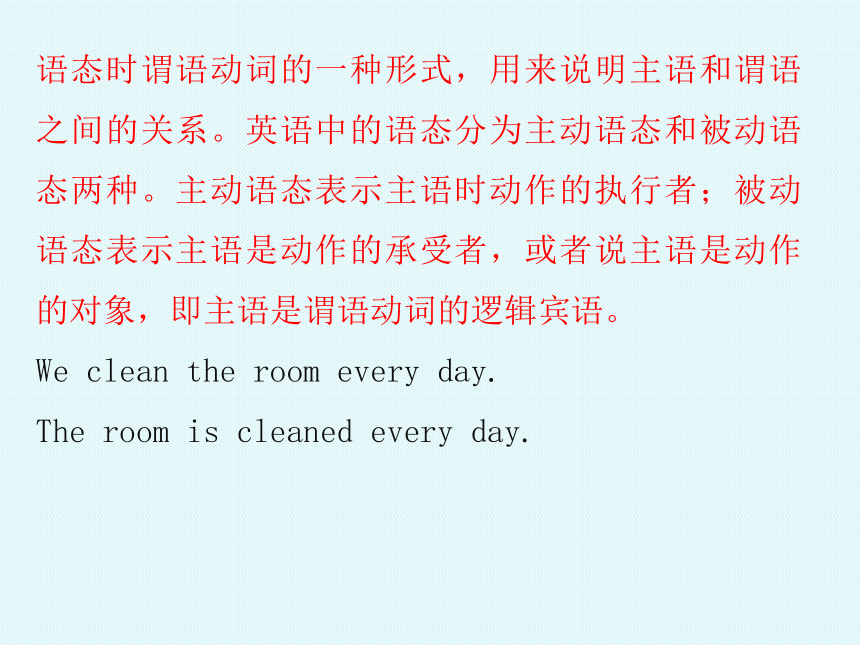

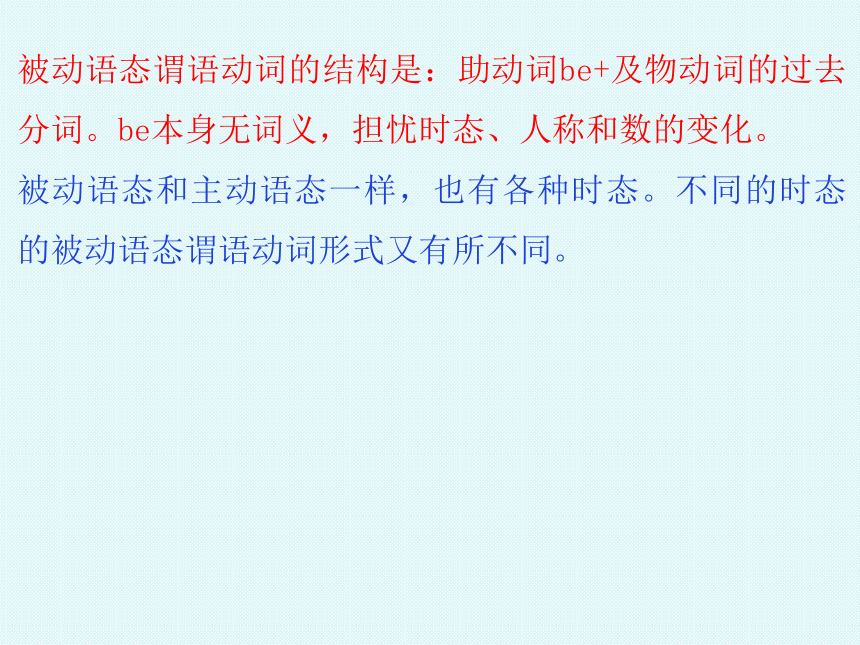
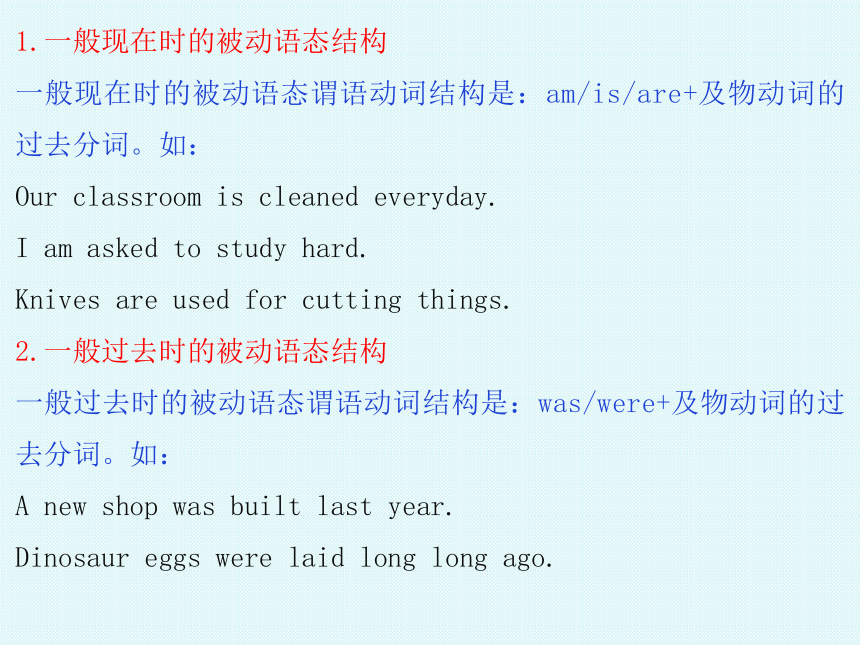
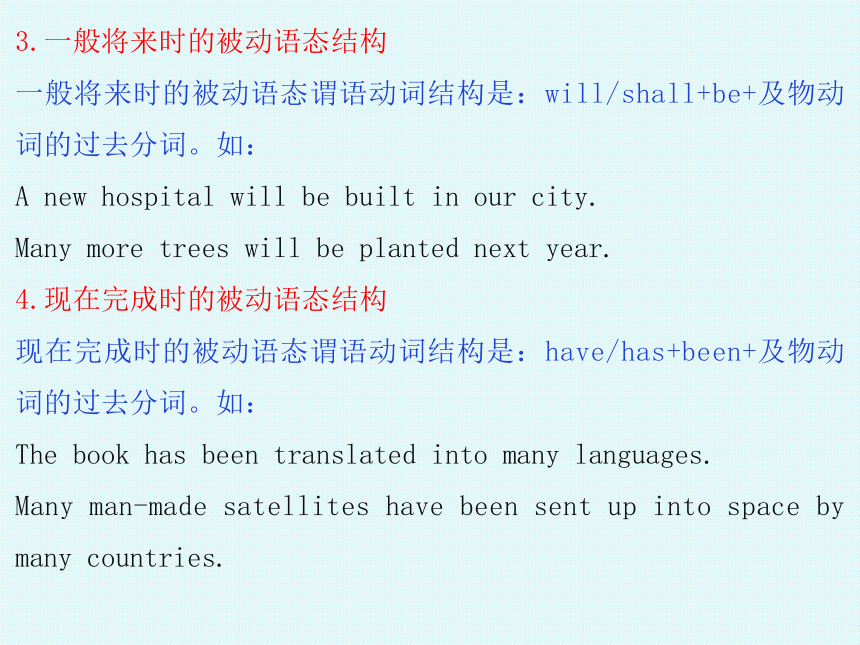
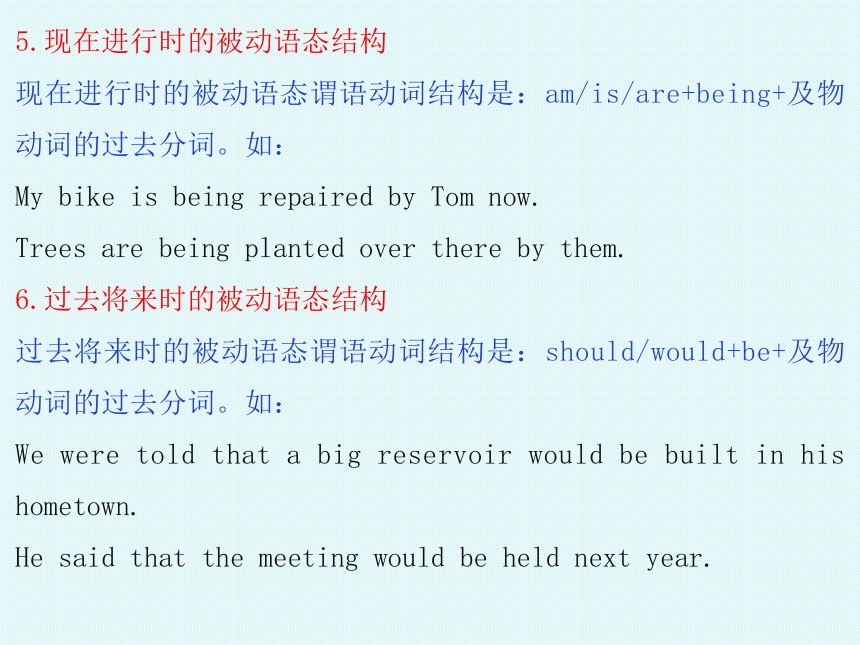

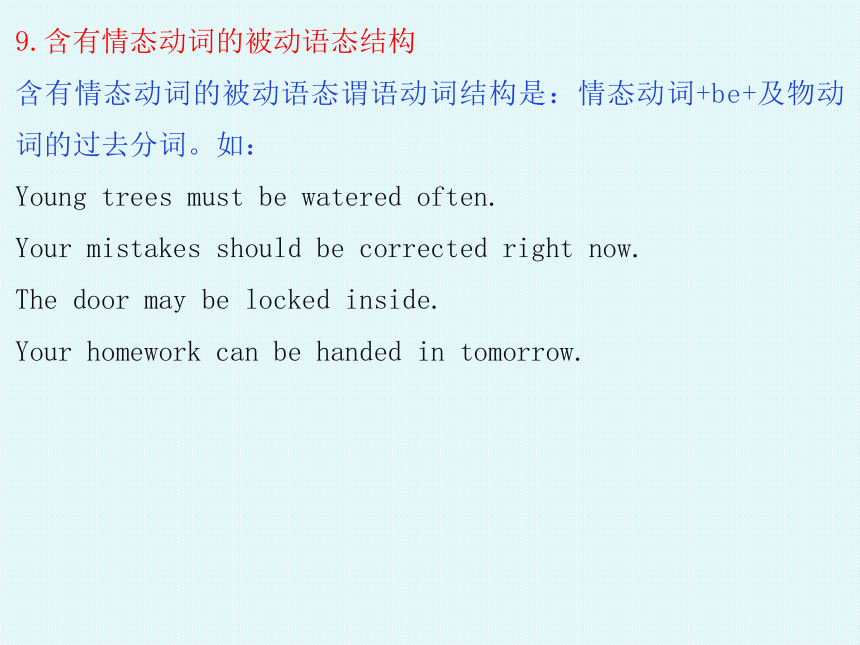
文档简介
(共20张PPT)
语态时谓语动词的一种形式,用来说明主语和谓语之间的关系。英语中的语态分为主动语态和被动语态两种。主动语态表示主语时动作的执行者;被动语态表示主语是动作的承受者,或者说主语是动作的对象,即主语是谓语动词的逻辑宾语。
We clean the room every day.
The room is cleaned every day.
被动语态的构成
被动语态谓语动词的结构是:助动词be+及物动词的过去分词。be本身无词义,担忧时态、人称和数的变化。
被动语态和主动语态一样,也有各种时态。不同的时态的被动语态谓语动词形式又有所不同。
1.一般现在时的被动语态结构
一般现在时的被动语态谓语动词结构是:am/is/are+及物动词的过去分词。如:
Our classroom is cleaned everyday.
I am asked to study hard.
Knives are used for cutting things.
2.一般过去时的被动语态结构
一般过去时的被动语态谓语动词结构是:was/were+及物动词的过去分词。如:
A new shop was built last year.
Dinosaur eggs were laid long long ago.
3.一般将来时的被动语态结构
一般将来时的被动语态谓语动词结构是:will/shall+be+及物动词的过去分词。如:
A new hospital will be built in our city.
Many more trees will be planted next year.
4.现在完成时的被动语态结构
现在完成时的被动语态谓语动词结构是:have/has+been+及物动词的过去分词。如:
The book has been translated into many languages.
Many man-made satellites have been sent up into space by many countries.
5.现在进行时的被动语态结构
现在进行时的被动语态谓语动词结构是:am/is/are+being+及物动词的过去分词。如:
My bike is being repaired by Tom now.
Trees are being planted over there by them.
6.过去将来时的被动语态结构
过去将来时的被动语态谓语动词结构是:should/would+be+及物动词的过去分词。如:
We were told that a big reservoir would be built in his hometown.
He said that the meeting would be held next year.
7.过去进行时的被动语态结构
过去进行时的被动语态谓语动词结构是:were/was+being+及物动词的过去分词。如:
He said that the man was being operated on.
He told me that a new station was being built there.
8.过去完成时的被动语态结构
过去完成时的被动语态谓语动词结构是:had+been+及物动词的过去分词。如:
He said that the work had been finished.
When I got to the theater,I found the tickets had already been sold out.
9.含有情态动词的被动语态结构
含有情态动词的被动语态谓语动词结构是:情态动词+be+及物动词的过去分词。如:
Young trees must be watered often.
Your mistakes should be corrected right now.
The door may be locked inside.
Your homework can be handed in tomorrow.
被动语态的用法
1.强调动作的承受者
主语应该是说话者要突出强调的重点。如果我们感兴趣的重点发动作的承受者(实语,就用被动语态将其宾语交为主语使其突出。
Many houses were destroyed in the earthquake of April 20,203 in Ya’an.
A new idea has been suggested.
2. 没有必要指出动作的执行者
说话者不知道动作的执行者,或者认为没有必要指出。
Do you know when the first train was produced in China
The house is being repaired.
3. 强调动作的执行者
被动句有时不用by短语,因为使用被动句多因动作执行者不明确或者不重要,但是有时也用by短语来强调或突出重要的、新的信息。
The painting on the wall is very valuable.
It was done by Picasso
主动语态与被动语态的转换
1.“主+谓+宾”结构
(1)把主动的宾语变为被动句的主语;
(2)把主动句的谓语动词变为be+过去分词形式;
(3)把主动句的主语放到介词by后面组成介词短语,置于被动句后作状语;
Taotao broke the window yesterday.
→The window was broken by Taotao yesterday.
His speech moved us deeply.
→We were deeply moved by his speech.
2.“主+谓+间宾+直宾”结构
及物动词buy,give,borrow,lend,send,bring,take,ask,teach,show,offer,tell,sell,pay等在句中常常带双宾语,一个指人,一个指物。指人的叫间接宾语,简称间宾;指物的叫直接宾语,简称直宾。含有双宾语的句子由主动语态变为被动语态时,通常只将其中一个宾语作为被动语态的主语。
They offered me a job in the company.
→I was offered a job in the company.
Father gave me a nice present.
→A nice present was given to me by father.
3.“主+谓+宾语+宾补”结构
含有复合宾语(宾语+宾语补足语)的主动句变为被动句时,将主动的宾语变为被动句的主语,而主动句中的宾语补足语保留不动,成为主语补足语。常见动词有:call,make,choose,regard,name,believe,paint,think等。
We painted the wall white.
→The wall was painted white by us.
主动语态表示被动含义
(1) 某些连系动词,如look, sound, smell, taste, feel, prove等,可用主动语态表示被动含义。
This shirt feels much softer than that one.
Everything will prove to be all right in the end.
(2) 表示主语的特征、状态的动词作谓语时。
表示主语的特征、状态的动词常见的有read, write, sell, clean, cook, burn, draw, cut, wear等,此类动词常表示主语的某种属性。
Her new novel sells well.
This kitchen cleans very easily.
(3) 当open, close, shut, lock, move等用作不及物动词且表示主语的某种属性时,通常用主动形式表示被动意义。此类动词通常与can't, won't等连用。
eg: The door won't shut.
eg: Suddenly the door opened.
(4)动名词的主动形式表被动意义。
作“需要”讲的need, want, require后的动名词用主动形式表示被动意义,相当于不定式的被动式。
eg: The problem requires studying with great care. = The problem requires to be studied with great care.
语态时谓语动词的一种形式,用来说明主语和谓语之间的关系。英语中的语态分为主动语态和被动语态两种。主动语态表示主语时动作的执行者;被动语态表示主语是动作的承受者,或者说主语是动作的对象,即主语是谓语动词的逻辑宾语。
We clean the room every day.
The room is cleaned every day.
被动语态的构成
被动语态谓语动词的结构是:助动词be+及物动词的过去分词。be本身无词义,担忧时态、人称和数的变化。
被动语态和主动语态一样,也有各种时态。不同的时态的被动语态谓语动词形式又有所不同。
1.一般现在时的被动语态结构
一般现在时的被动语态谓语动词结构是:am/is/are+及物动词的过去分词。如:
Our classroom is cleaned everyday.
I am asked to study hard.
Knives are used for cutting things.
2.一般过去时的被动语态结构
一般过去时的被动语态谓语动词结构是:was/were+及物动词的过去分词。如:
A new shop was built last year.
Dinosaur eggs were laid long long ago.
3.一般将来时的被动语态结构
一般将来时的被动语态谓语动词结构是:will/shall+be+及物动词的过去分词。如:
A new hospital will be built in our city.
Many more trees will be planted next year.
4.现在完成时的被动语态结构
现在完成时的被动语态谓语动词结构是:have/has+been+及物动词的过去分词。如:
The book has been translated into many languages.
Many man-made satellites have been sent up into space by many countries.
5.现在进行时的被动语态结构
现在进行时的被动语态谓语动词结构是:am/is/are+being+及物动词的过去分词。如:
My bike is being repaired by Tom now.
Trees are being planted over there by them.
6.过去将来时的被动语态结构
过去将来时的被动语态谓语动词结构是:should/would+be+及物动词的过去分词。如:
We were told that a big reservoir would be built in his hometown.
He said that the meeting would be held next year.
7.过去进行时的被动语态结构
过去进行时的被动语态谓语动词结构是:were/was+being+及物动词的过去分词。如:
He said that the man was being operated on.
He told me that a new station was being built there.
8.过去完成时的被动语态结构
过去完成时的被动语态谓语动词结构是:had+been+及物动词的过去分词。如:
He said that the work had been finished.
When I got to the theater,I found the tickets had already been sold out.
9.含有情态动词的被动语态结构
含有情态动词的被动语态谓语动词结构是:情态动词+be+及物动词的过去分词。如:
Young trees must be watered often.
Your mistakes should be corrected right now.
The door may be locked inside.
Your homework can be handed in tomorrow.
被动语态的用法
1.强调动作的承受者
主语应该是说话者要突出强调的重点。如果我们感兴趣的重点发动作的承受者(实语,就用被动语态将其宾语交为主语使其突出。
Many houses were destroyed in the earthquake of April 20,203 in Ya’an.
A new idea has been suggested.
2. 没有必要指出动作的执行者
说话者不知道动作的执行者,或者认为没有必要指出。
Do you know when the first train was produced in China
The house is being repaired.
3. 强调动作的执行者
被动句有时不用by短语,因为使用被动句多因动作执行者不明确或者不重要,但是有时也用by短语来强调或突出重要的、新的信息。
The painting on the wall is very valuable.
It was done by Picasso
主动语态与被动语态的转换
1.“主+谓+宾”结构
(1)把主动的宾语变为被动句的主语;
(2)把主动句的谓语动词变为be+过去分词形式;
(3)把主动句的主语放到介词by后面组成介词短语,置于被动句后作状语;
Taotao broke the window yesterday.
→The window was broken by Taotao yesterday.
His speech moved us deeply.
→We were deeply moved by his speech.
2.“主+谓+间宾+直宾”结构
及物动词buy,give,borrow,lend,send,bring,take,ask,teach,show,offer,tell,sell,pay等在句中常常带双宾语,一个指人,一个指物。指人的叫间接宾语,简称间宾;指物的叫直接宾语,简称直宾。含有双宾语的句子由主动语态变为被动语态时,通常只将其中一个宾语作为被动语态的主语。
They offered me a job in the company.
→I was offered a job in the company.
Father gave me a nice present.
→A nice present was given to me by father.
3.“主+谓+宾语+宾补”结构
含有复合宾语(宾语+宾语补足语)的主动句变为被动句时,将主动的宾语变为被动句的主语,而主动句中的宾语补足语保留不动,成为主语补足语。常见动词有:call,make,choose,regard,name,believe,paint,think等。
We painted the wall white.
→The wall was painted white by us.
主动语态表示被动含义
(1) 某些连系动词,如look, sound, smell, taste, feel, prove等,可用主动语态表示被动含义。
This shirt feels much softer than that one.
Everything will prove to be all right in the end.
(2) 表示主语的特征、状态的动词作谓语时。
表示主语的特征、状态的动词常见的有read, write, sell, clean, cook, burn, draw, cut, wear等,此类动词常表示主语的某种属性。
Her new novel sells well.
This kitchen cleans very easily.
(3) 当open, close, shut, lock, move等用作不及物动词且表示主语的某种属性时,通常用主动形式表示被动意义。此类动词通常与can't, won't等连用。
eg: The door won't shut.
eg: Suddenly the door opened.
(4)动名词的主动形式表被动意义。
作“需要”讲的need, want, require后的动名词用主动形式表示被动意义,相当于不定式的被动式。
eg: The problem requires studying with great care. = The problem requires to be studied with great care.
同课章节目录
- 词法
- 名词
- 动词和动词短语
- 动词语态
- 动词时态
- 助动词和情态动词
- 非谓语动词
- 冠词
- 代词
- 数词和量词
- 形容词副词及其比较等级
- 介词和介词短语
- 连词和感叹词
- 构词法
- 相似、相近词比较
- 句法
- 陈述句
- 一般疑问句和否定疑问句
- 特殊疑问句及选择疑问句
- 反意疑问句
- 存在句(There be句型)
- 宾语从句
- 定语从句
- 状语从句
- 主谓一致问题
- 简单句
- 并列句
- 复合句
- 主谓一致
- 主、表语从句
- 名词性从句
- 直接引语和间接引语
- 虚拟语气
- 感叹句
- 强调句
- 倒装句
- 祈使句
- 句子的成分
- 句子的分类
- 题型专区
- 单项选择部分
- 易错题
- 完形填空
- 阅读理解
- 词汇练习
- 听说训练
- 句型转换
- 补全对话
- 短文改错
- 翻译
- 书面表达
- 任务型阅读
- 语法填空
- 其他资料
